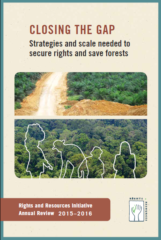
In 2005, RRI proposed a goal of doubling the area of forest land in developing countries that is legally owned by or designated for Indigenous Peoples and local communities by 2015. That figure stood at 21 percent in 2002 and reached 31 percent by the end of 2015, still short of the target but a dramatic advance for local communities and Indigenous Peoples nonetheless.
Today, new research indicates that Indigenous Peoples and local communities hold property rights to almost 500 million hectares of forest land in developing countries. Ten years ago, it was a struggle to make indigenous and community rights part of global discussions on forest conservation and climate change.
By the close of 2015, it was clear that the case had been made. But implementation has been slow with millions of Indigenous Peoples and local communities still lacking legal rights to the vast majority of their customary lands, putting at risk their livelihoods and the sustainability of hundreds of millions of hectares of forest.
While in 2015 many governments continued to ignore the tenure rights of local communities and Indigenous Peoples, some gains have been made. Closing the Gap: Strategies and scale needed to secure rights and save forests shows that there were signs of progress as a core group of countries prepared to implement the recognition of community land rights at a national scale.
